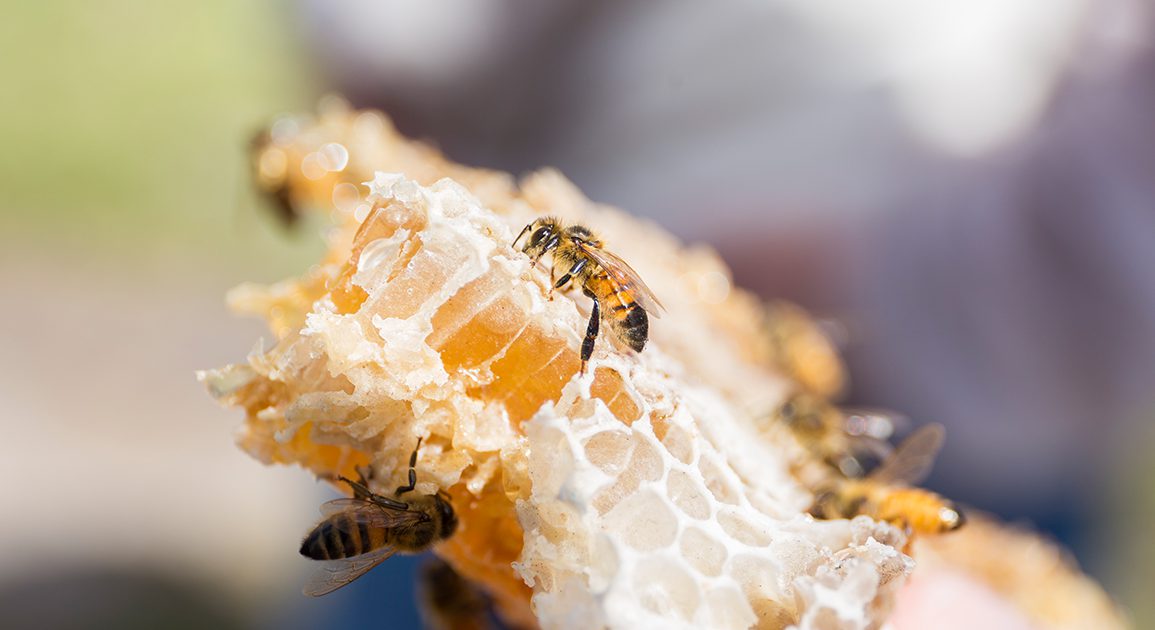These days, it seems like everyone is interested in bees — in part, due to honey bees’ vital role in growing our food, as well as reports of their declining numbers.
Even as the public’s fascination with honey bees continues to grow, much of the science of honey bees isn’t common knowledge, says a University of Florida honey bee researcher.
“One of the highlights of being a bee scientist is educating the public about these insects and what research is doing to help bees and beekeepers do well,” said Jamie Ellis, Gahan endowed professor and director of the Honey Bee Research and Extension Laboratory in the UF Institute of Food and Agricultural Sciences.
August 17 is National Honey Bee Day. Here are a few things about honey bees you probably didn’t know.
1. Honey bees aren’t native to North America
The honey bees we keep in the U.S. are actually from Europe, Ellis said. They were introduced to the Americas through European colonization.
However, North America has many native bees, which don’t make honey but are still important pollinators, he said.
2. They are responsible for pollinating some of our most nutrient-dense crops.
Considerable fruit and vegetable production is a result of honey bee pollination, Ellis said. “Avocados, blueberries, squash, watermelon, mangoes—they all need bees to exist,” he said.
3. Pure honey never spoils.
“Honey is very low in water and pretty acidic, making it a bad environment for microbes,” Ellis said. However, anything added to honey that increases the water content or reduces its acidity can reduce its shelf life.
4. They can learn and recognize landmarks.
“Here at the lab we have several observation hives that are inside a building. Each hive is connected to a passage that gives bees access to the outside. To help bees return to the hive where they live, we put different colored signs next to the different access points, and this is because bees can actually learn to associate their home with markers such as these,” Ellis said.
5. Bees communicate through interpretive dance.
“Bees go out into the world to find nectar and pollen and bring it back to the hive. When they’ve found a location where the nectar and pollen are good, they tell their nestmates about it through what we call the Waggle Dance,” Ellis said. “The dance tells the other bees how far away the food is and what direction to fly to find it.”
6. Their family dynamics sound like a soap opera plot.
“The majority of the bees in a hive are female worker bees, and they are actually all sisters—about 20,000 sisters. Their mother is the queen bee, and her sole function is to lay eggs, about one to two thousand every day. The worker bees are responsible for rearing potential queens. When that first queen hatches, she kills all other would-be queens,” Ellis said.
Ellis adds that a male honey bee, called a drone, is born from one of the queen’s unfertilized eggs. So, male honey bees do not have fathers, though they do have grandfathers on their mother’s side.
7. One Florida honey bee hive can produce 50 to 100 pounds of honey per year.
Honey is derived from the nectar of flowers. “Honey bees bring the nectar back to hive, where they fan it with their wings until most of the water has evaporated. Then they seal the honey in the comb with wax,” Ellis said.
8. One of the biggest threats to bees is a tiny mite.
While there are several factors that lead hives to fail, one of the biggest is a tiny creature called the Varroa mite. “The mite is a parasite, attacking bees’ fat tissues, killing immature bees and weakening adult ones. If it’s not controlled, the mite reproduces more quickly than the bees can, and this leads the death of the colony,” Ellis said.
However, researchers at the UF/IFAS Honey Bee Lab are developing ways to prevent and manage Varroa, ultimately helping beekeepers maintain their hives.
9. Honey bees can’t see red.
“Bees can see combinations of blue, green and ultraviolet light, but red appears black to them,” Ellis said. “At our lab, our observation room has several hives with glass walls that allow us to see what’s going on inside the hive. However, the behavior of bees changes when the bees are viewed under ordinary light. So, our observation room is lit with red light. This allow us to see them, but they don’t notice us.”
10. A honey bee colony is a superorganism.
“The honey bee colony is one of those classic examples of a superorganism. That’s because even though the colony is composed of individuals, each individual has a specific job that helps sustain the whole community. The whole community, then, can be thought of as a complex organism itself,” Ellis said.
This article was originally published on UF/IFAS News.

